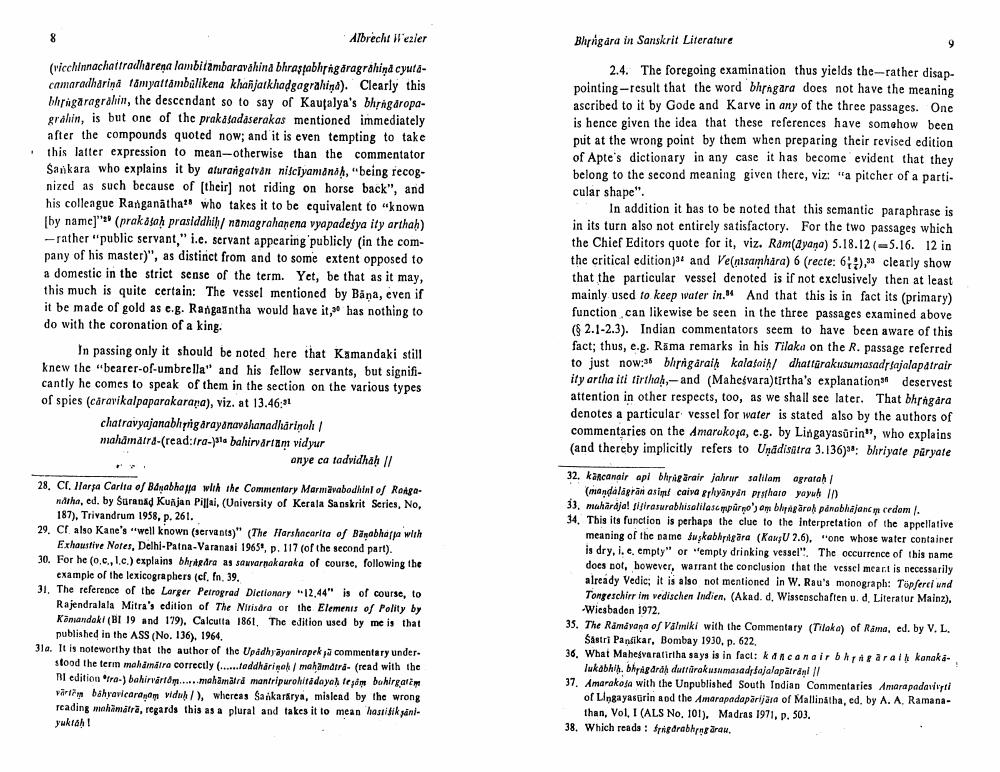Book Title: Bhrngara In Sanskrit Literature Author(s): A Wezler Publisher: A Wezler View full book textPage 5
________________ Albrecht Wezier Bhrigara in Sanskrit Literature (vicchinnachaitradharena lambidambaravahina bhrasabhragaragrahind cyutdcamaradharind famyattambalikena khanjatkhadgagrahind). Clearly this bhrigaragrahin, the descendant so to say of Kausalya's bhrágáropagrahin, is but one of the prakasadaserakas mentioned immediately after the compounds quoted now, and it is even tempting to take this latter expression to mean-otherwise than the commentator Sankara who explains it by aturargatvan nilciyamanah, being recognized as such because of their) not riding on horse back", and his colleague Ranganathats who takes it to be equivalent to "known by name]*** (praksah prasiddhih/ namagrahanena vyapadesya ity arthah) -- rather "public servant," i.e. servant appearing publicly in the company of his master)", as distinct from and to some extent opposed to a domestic in the strict sense of the term. Yet, be that as it may, this much is quite certain: The vessel mentioned by Bana, even if it be made of gold as e.g. Ranga Intha would have it," has nothing to do with the coronation of a king. In passing only it should be noted here that Kamandaki still knew the "bearer-of-umbrella" and his fellow servants, but significantly he comes to speak of them in the section on the various types of spies (caravikalpaparakarana), viz. at 13.46:31 chatravyajanabhrrigarayanavahanadharinah / mahdmdird-(read:1ra-yale bahirvartan vidyur enye ca tadvidhah Il 2.4. The foregoing examination thus yields the-rather disappointing-result that the word bhragara does not have the meaning ascribed to it by Gode and Karve in any of the three passages. One is hence given the idea that these references have somehow been put at the wrong point by them when preparing their revised edition of Apte's dictionary in any case it has become evident that they belong to the second meaning given there, viz: "a pitcher of a particular shape". In addition it has to be noted that this semantic paraphrase is in its turn also not entirely satisfactory. For the two passages which the Chief Editors quote for it, viz. Ramayana) 5.18.12(-5.16. 12 in the critical edition and Ve(nisamhara) 6 (recte: 6+), clearly show that the particular vessel denoted is if not exclusively then at least mainly used to keep water in. And that this is in fact its (primary) function can likewise be seen in the three passages examined above ($ 2.1-2.3). Indian commentators seem to have been aware of this fact; thus, e.g. Rama remarks in his Tilaka on the R. passage referred to just now: bhrrigaraih kalafaial dhattarakusumasad Sajalapatrair ity artha iti tirthak-and (Mahesvara)tirtha's explanation" deservest attention in other respects, too, as we shall see later. That bhrngara denotes a particular vessel for water is stated also by the authors of commentaries on the Amarokopa, c.g. by Lingayasurin", who explains (and thereby implicitly refers to Unadisgtra 3.136): bhriyate püryale 28. C lara Carlia o Bdyabha with the Commentary Marmavabodhint of Ranga natha, ed. by Surabad Kurjan Pillai. (University of Kerala Sanskrit Scries, No. 187), Trivandrum 1958, p. 261. 29. Ct also Kane's "well known (servants)" (The Farshacarita of Başabharpa with Exhaustive Notes, Delhi-Patna-Varanasi 1965, p. 117 of the second part). 30. For he (o.c., 1.c.) explains bly arra as sauvarnakaraka of course, following the example of the lexicographers (cf. n. 39. 31. The reference of the Larger Petrograd Dictionary -12,44" is of course, to Rajendralala Mitra's edition of The Nirisdra or the Elemenis of Polity by Könandoki (BI 19 and 179). Calcutta 1861. The edition used by me is that published in the ASS (No. 136). 1964. 31a. It is noteworthy that the author of the Upadhyayenireprka commentary under stood the term makamotra correctly (......feddharine mehamdird- (read with the I edition fro-) bahirvärtom.....mahāmatri mantripurohitadaye tepim bohirgalim variy bahyavicardom wduh/), whereas Sarkarirya, mislead by the wrong reading mahämätrā, regards this as a plural and takes it to mean hasiidikanle yuklah! 32. kancanair api bhripärair jahrur sallam agrarah (mandalagrānasim caiva &rhyānyan prstharo yayub in 33, maharajal si/irasurabhisalilase mpros am bhoparel pdnobhajan yecedom. 34. This its function is perhaps the clue to the Interpretation of the appellative meaning of the same duskab pisara (KangU 2.6). "one whose water container is dry, i.e. empty" or "empty drinking vessel". The occurrence of this name does not, bowever, warrant the conclusion that the vessel meart is necessarily already Vedic; it is also not mentioned in W. Rau's monograph: Topferei und Tongeschirr im wedischen Indien. (Akad. d. Wisscoschaften u. d. Literatur Mainz). -Wiesbaden 1972. 35. The Ramayaņa of Valmiki with the Commentary (Tilaka) of Rama, ed. by V. L. Sastri Pansikar, Bombay 1930, p. 622. 36. What Mahesvaratirtha says is in fact: kacanair bh a ral kanak lukabhi bhpagdra durarakusumasadpajalapatral II 37. Amarakosa with the Unpublished South Indian Commentaries Amara padavineyti of Lingayasorin and the Amarapadapārijāra of Mallinátha, ed. by A. A. Ramana than, Vol. 1 (ALS No. 10). Madras 1971, p. 503. 38. Which reads: Aprgdrabhag arau.Page Navigation
1 ... 3 4 5 6 7 8 9 10 11 12 13 14 15 16 17 18 19 20 21 22 23
